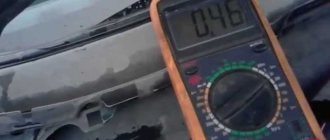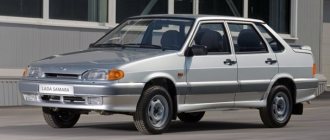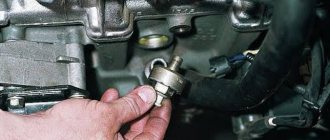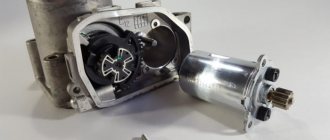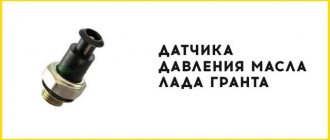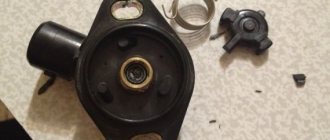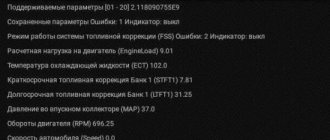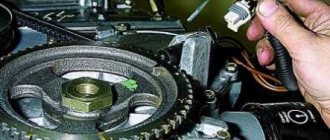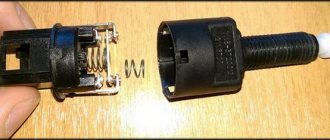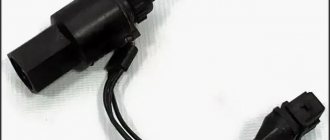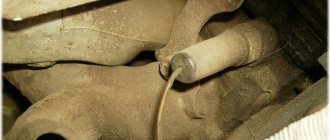01 April 2020 Lada.Online 32 477 0
The fault indicator (Check Engine) on Chevrolet Niva cars is located in the instrument cluster. When the warning light turns on, it signals to the driver that the on-board diagnostic system has detected a malfunction of the ECM and the vehicle continues to move in emergency mode. To determine the cause, you should use a diagnostic tool, with which you can read error codes and decipher them according to the table below.
Trouble P0328 Knock Sensor 1 Bank 1 Input High
Code P0328 is entered if the following conditions exist:
engine crankshaft speed is more than 1300 rpm; coolant temperature above 60°C; the amplitude of the knock sensor signal is above the threshold. If a permanent malfunction occurs, the “CHECK ENGINE” lamp lights up after 2 drive cycles.
1. The existence of conditions for the occurrence of code P0328 is checked.
2. The serviceability of the screen of wires 2 B and 88 G is checked.
1. Connect the adapter cable to the diagnostic connector. Start the engine and warm up to a coolant temperature of 60°C. Set the engine crankshaft speed to more than 1300 rpm.
Code P0328 is intermittent. If it is currently inactive and there are no other codes, analyze the conditions under which the code occurred. Check by ear the operation of the engine for the presence of extraneous metallic noises and knocking (valves are not adjusted); if found, eliminate them. Make sure that the sensor wiring harness is not routed near high voltage wires. See the “Checking the Knock Control System” card.
2. Check the serviceability of the screen and the connection between the screen and engine ground. Check the tightening torque of the knock sensor mounting nut.
If comments are found, the sensor or controller is faulty.
If there are no comments, fix the problem.
After repair, start the engine, reset the codes and make sure there is no signal from the “CHECK ENGINE” lamp.
The error is entered under the following conditions - in forced idling mode: 1. The amplitude of the DD signal is below the threshold value 2. The computer is operating in detonation control mode. Parameter BK_R is “NO”. 3. crankshaft rotation speed in the range of 2250 - 2350. It is necessary to check the condition of the DD connector for the presence of dust - dirt and engine oil... The error is entered into the ECU memory on the third drive cycle. On cars of the first production, the DD fastening was observed to be tightened with insufficient torque. Check procedure: 1. Turn off the ignition, connect the diagnostic tool, warm up the engine to a temperature of 90 degrees. We are trying to reproduce the conditions under which the error occurred. If the error is not active at the moment, check the tightness of the DD, the correct connection and the integrity of the wiring harness. 2. If the error is active, turn off the ignition, disconnect the wiring harness block from the engine control unit and the computer. We measure the resistance of the wires connecting the ECU and the DD. If the resistance is more than 1 ohm, we eliminate the break. 3. If the resistance is less than 1 Ohm, the motor control unit or ECU is faulty, or there is a weak contact in the wiring harness blocks.
Error 0328 - high signal level of the knock sensor The error is entered under the following conditions - in forced idling mode: 1. The amplitude of the DD signal is above the threshold value 2. The computer is operating in knock control mode. Parameter BK_R is “NO”. 3. The crankshaft rotation speed is in the range of 2250 – 2350. The error is entered into the ECU memory on the third drive cycle. Error 0328 may indicate deterioration or engine malfunction. It is necessary to check the condition of the engine hardware, especially the condition of the timing belt and timing gear. On cars of the first production, tightening of the motor drive fastening with insufficient torque was observed. Check procedure: 1. Turn off the ignition, connect the diagnostic tool, warm up the engine to a temperature of 90 degrees. We are trying to reproduce the conditions under which the error occurred. If the error is not active at the moment, check the tightness of the DD, the correct connection and the integrity of the wiring harness. 2. If the error is active, check the condition of the screen and its connection to engine ground. Check the tightening torque of the DD fastening. 3. If a fault in the wiring screen is not detected, the engine control unit or ECU is faulty; if a fault in the wiring screen is detected, eliminate the fault.
How does a mechanic diagnose a P0328 code?
When diagnosing this error code, a mechanic will do the following:
- Connects the OBD-II scanner to the vehicle's diagnostic connector and reads all stored data and error codes
- Clear error codes from the ECM and test drive the vehicle to see if P0328 appears again
- Find out if the engine makes a lot of noise during operation
- Inspect the knock sensor for damage
- Check the cooling system as well as the engine for damage
- Checks the octane number of the fuel, as well as the fuel system
- Check the knock sensor voltage
- Checks engine coolant temperature and fuel pressure
- Will check the ECM according to the manufacturer's procedure
Priora knock sensor
A knock sensor is a device that detects the knock levels of internal combustion engine processes. The installation location of such a device is the cylinder block. Maintaining it makes it possible to obtain high power, as well as achieve good fuel economy without causing damage to the engine.
The detonation process is the main defect of an internal combustion engine, since the force is considerable and it is impossible to ignore it. Among several different devices that are used as performance optimizations, the knock sensor is used to prevent knocking fuel combustions. Fuel detonation can be controlled thanks to the main indicator - the manifestation of high-pitched and ringing metallic sounds, which, according to indicators, are sometimes mistaken for the clicking sounds of the cylinder-piston group. If the process is strong enough, with faulty knock prevention systems the engine begins to fail.
Engine operating principle
Detonation very often occurs when going uphill.
In this case, the car is moving slowly, and the speed is increased. But do not worry, since this phenomenon is called glow ignition, and it does not indicate that the engine is not working properly. Any internal combustion engine works according to the following principles:
- A mixture of gasoline and air is supplied to the combustion chamber of the cylinders, where it is ignited by a spark on the spark plug. Moreover, the piston should be literally a few millimeters from top dead center. As soon as the piston reaches the top position, the greatest pressure is generated in the cylinder. At this moment, the entire air-fuel mixture will completely burn.
- During normal operation of the knock sensor on the Chevrolet Niva, signs of this phenomenon will not appear. This device will help get rid of the manifestation of detonation. And it appears when the mixture begins to ignite much earlier than it should. This usually happens halfway to top dead center. And when the air-fuel mixture burns, a force is exerted on the upper part of the piston, which pushes it in the opposite direction. At the same time, the engine power is reduced, and significantly, and its parts wear out.
- A mixture of gasoline and air is supplied to the combustion chamber of the cylinders, where it is ignited by a spark on the spark plug. Moreover, the piston should be literally a few millimeters from top dead center. As soon as the piston reaches the top position, the greatest pressure is generated in the cylinder. At this moment, the entire air-fuel mixture will completely burn.
- During normal operation of the knock sensor on the Chevrolet Niva, signs of this phenomenon will not appear. This device will help get rid of the manifestation of detonation. And it appears when the mixture begins to ignite much earlier than it should. This usually happens halfway to top dead center. And when the air-fuel mixture burns, a force is exerted on the upper part of the piston, which pushes it in the opposite direction. At the same time, the engine power is reduced, and significantly, and its parts wear out.
Additional comments for troubleshooting P0328
When diagnosing the P0328 code, it is very important to follow the diagnostic protocol to ensure all checks and repairs are performed correctly.
To make a proper diagnosis, a mechanic will need a professional scanner that can not only read stored error codes, but can also view data from various sensors, such as fuel pressure and engine coolant temperature, in real time.
Need help with error code P0328?
The company - CarChek, offers a service - on-site computer diagnostics; specialists from our company will come to your home or office to diagnose and identify problems with your car. Find out the cost and sign up for on-site computer diagnostics or contact a consultant by phone
On which cars is this problem most common?
The problem with code P0328 can occur on different machines, but there are always statistics on which brands this error occurs more often. Here is a list of some of them:
- Audi (Audi a4)
- Chevrolet (Chevrolet Captiva)
- Hyundai (Hyundai Accent, Elantra)
- Infiniti (Infiniti fx35)
- Kia (Kia Sid, Cerato)
- Lexus
- Mazda (Mazda 2, Mazda 3, Mazda 6, Demio, Premasi)
- Nissan (Nissan Almera, Xterra, Murano, Teana, Frontier)
- Opel (Opel Astra)
- Skoda (Skoda Octavia)
- Subaru (Subaru Outback, Tribeca, Forester)
- Suzuki
- Toyota (Toyota Avensis, Camry, Rav4, Sienna)
- Volkswagen (Volkswagen Passat, Polo)
- VAZ 2109, 2110, 2112, 2114, 2115
- Lada Kalina, Niva, Priora
With fault code P0328, you can sometimes encounter other errors. The most common ones are: P0132, P0152, P0158, P0171, P0183, P0324, P0325, P0326, P0327, P0329, P0330, P0331, P0332, P0333, P0334, P0400, P0451, P0463, P0496.
How to remove and check the sensor?
Access from above to the Priora DD is difficult due to the intake module located above it. The easiest way to get to the sensor is from below, first removing the engine protection or at least unscrewing and folding its front part. When working from above, you will have to do everything by touch. In any case, before starting work, it is necessary to disconnect the ground wire attached to the “negative” terminal from the battery.
To remove the crankcase protection, you need to:
- unscrew 5 nuts with a 10mm head;
- unscrew the 2 19 nuts installed on the back of the shield;
- remove protection.
- by pressing the metal latch of the DD connector, disconnect the block of wires going to the controller;
- using a 13mm wrench, loosen the bolt securing the sensor;
- Unscrew the bolt and remove it from the threaded hole, removing the sensor.
Photo of dismantling the knock sensor
- We connect a multimeter to the DD terminals. We set the device to voltmeter mode, choosing a measurement limit of up to 200 mV.
- We take a metal object - pliers or a bolt - and lightly tap it on the DD.
When you tap on a working sensor, the voltmeter will show voltage surges. A faulty DD will not react in any way. A more accurate diagnosis of a removed sensor can only be done using a special stand.
In the photo - diagnostics of the knock sensor
Installation of a new DD is carried out in the reverse order of dismantling. Experts recommend installing a similar Bosch instead of the “native” one. Before going to the store for a new sensor, you should write down the markings of the removed sensor. The bolt securing it to 13 must be tightened with a slight force - 10.4–24.2 Nm (1.1–2.5 kgf). Tightening too tightly will affect the operation of the sensor.
Sensor cost
The knock sensor has extremely low maintainability. Usually, when it fails, it requires replacement with a new DD. The original General Motors sensor has part number 21120-3855020-02-0. Its price is 450-550 rubles. If there is a need to change the DD, then you can purchase an analogue. The table below presents the best alternative options for a branded product.
Table - Good analogues of the original Chevrolet Niva knock sensor
| Manufacturer | vendor code | Approximate cost, ruble |
| Bosch | 0 261 231 046 | 850-1000 |
| Fenox | SD10100O7 | 500-850 |
| Lada | 21120-3855020 | 190-250 |
| AvtoVAZ | 211203855020020 | 300-350 |
| EPS | 1.957.001 | 400-500 |
What does it indicate?
The appearance of error P0325 indicates incorrect operation of the knock sensor, or more precisely, the presence of faults in its circuit. The device is installed on the cylinder block or intake manifold. It is designed to detect engine detonation using a piezoelectric element located in it.
The sensor perceives vibration of the cylinder blocks as an oscillatory movement. The pressure is then converted into a voltage signal and transmitted to the engine control module. Error code P0325 occurs when the sensor voltage level is too low or, conversely, too high. This does not have a critical impact on the operation of the engine as a whole, and the driver has time to safely get to the service station.
Often, along with the P0325 error, related errors appear, which also indicate problems with detonation. All of them occur due to damage to the sensor or the use of low quality fuel.
- P0326 – the sensor signal is outside the permissible limits.
- P0327 - decrease in the signal level of the knock sensor.
- P0328 - signal level exceeded.
High signal level - warning codes
Many motorists have encountered the problem of various knock regulator warning signals. One of them may be P0328 - high signal level of the knock sensor . It can cause not only a malfunction of the device itself, but also, for example, too noisy operation of the engine. The best solution to the problem is to contact a service station so that they can diagnose the car, in particular, the element itself.
In addition, there is another signal that the driver can receive from the system - 0327, this code means a low level of the detonation signal. As a rule, it occurs in several cases - either after a long descent with the gear engaged, or in a situation when replacing the sensor is already necessary. In any case, you will either have to check its serviceability on your own; for this it is better to dismantle it and connect it to special equipment, or do this with the help of specialists.
Signs of a malfunctioning knock sensor
Resistance that should be in the sensor in good condition
Before considering the causes, it is necessary to look at the symptoms of the malfunction. So, let's look at what could be a warning sign that the knock sensor has failed:
- The engine is losing power.
- Overclocking potential drops.
- Fuel consumption has increased.
- The CHECK light came on on the instrument panel.
- Smoky exhaust.
- Presence of detonation.
- The engine started to stall.
Of course, an important reason for the failure of the knock sensor is the fuel mixture, namely the quality of gasoline itself. The lower the octane number, the lower the resistance to detonation. If the fuel detonates, it will not completely burn through the engine and you will hear the muffler firing.
Knock sensor diagnostics
The sensor is checked with a multimeter. In this case, the sensor is “knocked” with a screwdriver
To diagnose the knock sensor, it is removed from the engine and a voltmeter with a measurement limit of up to 200 mV is connected to it.
Next, they “knock” the sensor on a hard surface and look at the voltmeter readings. When tapping, the readings should change. If they do not change, this means that the sensor is not working. If they change, then the sensor readings change, but whether they are correct is in question!
ECU signal about malfunction
Failure of the sensor will be immediately obvious by a characteristic knocking sound. Many motorists simply reset the “minus terminal” to reset the readings of the electronic control unit, but it is worth understanding the very reasons for the effect and eliminating them. Let's look at the ECU error codes that signal a failure of the knock sensor:
- code-0325 hints at network problems. For example, a break in the wiring or acidification of the plug contacts. In this case, we call the electrical circuit connecting the sensor, clean the electrical contacts ;
Error 0325 on the BC STATE screen (Open circuit of the knock sensor)
Type of knock sensor
Decoding Chevrolet Niva error codes
There is a monochrome display on the car's instrument panel. Basic information about the results and progress of self-diagnosis is displayed here.
The full list of faults is long. The factory table contains hundreds of codes, which is impossible to list. Below are explanations of the most popular faults.
Error 1 1
The power steering system does not work correctly. The module needs to be diagnosed. There may be leaks in the sealing elements.
Error 1 6
The code is an information message notifying about malfunctions in the on-board electrical circuit.
Code 2
The float in the fuel tank is out of order or does not respond. The element may have been damaged due to a strong impact or shaking. Wiring failure cannot be ruled out.
Error 8: Shniva
If the system issues a similar failure code, an inspection of the battery and power lines will help correct the situation. The corresponding indicator on the dashboard often lights up.
The error clearly indicates that the voltage in the on-board network is too low.
Code 10
Typically the error consists of two problems. Here there is an open circuit of the float and a voltage drop in the on-board network. Problems are resolved in the order determined by the owner.
Code 11
A similar breakdown indicating two problems at the same time. There is a double meaning of the cipher here, and the combination is determined in the same way as in No. 10.
Error 12: decryption
The system reports a breakdown of the vehicle's control indicator. The Check lamp will not light up even if there is a serious malfunction. As a repair, it is enough to replace the damaged element.
Error 14
The symbol means that the temperature of the antifreeze in the radiator is too high - the engine has overheated. Stop and let the system cool down. It is recommended to check the lines for leaks.
Shniva: error 16
The problem is complex and indicates the presence of errors 4 and 12. Troubleshooting is described above.
P0036 - error
It indicates an open circuit in the oxygen sensor control circuit No. 2. You should find a gap in the line.
Error 0101
The mass air flow sensor shows that the air flow does not correspond to the required one. Engine performance may drop significantly during operation.
Error P0102
He says that the signal coming from the DRV is too low. The problem is that the working part of the sensor is clogged.
Fault 0103
The opposite meaning to the above problem. The sequence of actions during repairs is similar.
Breakdown 0115
The problem is related to the coolant temperature sensor. Replace the faulty element with a new one.
Code 0123
The signal from the TPS is too high. The problem is in the throttle sensor or mechanical part.
Code 0130
Incorrect data from DC1 installed before the neutralizer. Check the sensor for contamination. If the working part is clogged, the entire module is replaced.
Breakdown 0134
Open circuit DC1. The sensor is located under the bottom of the car, which often causes stones and dirt to get into the wiring.
Code P0135
Heater circuit DK1 – no signal. Check the contact groups for oxidation and dirt.
Code 0139
The response of DK2 installed after the neutralizer is too slow. The breakdown is eliminated by diagnosing the sensor.
Code P0141
Heater DK2 is faulty. The code may be displayed as 0141 or 141.
Code P0171
The system issues 0171 - this means that the air-fuel mixture is excessively rich. Check the air line for blockages.
Error P0172
The module transmits a signal - the fuel mixture is too lean. Perform fuel line diagnostics. This is due to parasitic air suction through depressurized connections or worn hoses.
Shniva: error 0302
Multiple misfires in cylinder No. 2. Check the ignition system and fuel supply to the working chamber.
Shniva: error 0131
The signal level from DC1 is too low. The sensor grid is clogged.
Error 0328
The signal from the knock sensor is too high. A breakdown may indicate a short circuit in the internal parts of the sensor.
Error 0327
The signal level from the DD is too low. The power of the power plant often drops. The sensor needs to be checked or replaced with a new one.
Fault 0335
There is no signal from the DPKV. The wiring is damaged or the sensor is faulty.
Error 0336
The problem indicates that the control signal from the DPKV is outside the established limits. The problem is in the sensor.
Breakdown 0339
Incorrect operation of the crankshaft position sensor.
Error 0340
The problem indicates that the DPRV circuit is damaged, shorted, or completely broken.
Shniva: error code p0342
Signal too low. You need to check the control wires.
Breakdown 0343
The algorithm of actions will be the opposite. This is all due to damage to the sensor. The sensor needs to be tested using diagnostic equipment.
Malfunction P0422
Indicates that the catalyst is not working correctly. A similar glitch occurs even with short mileages and in different operating modes. To properly deal with it and not constantly reset the code, you will need to cut out the catalyst or replace the sensor, which does not always help.
Code 0441
The air flow through the valve is incorrect. Conduct diagnostics of the module and remove all contaminants.
Error 0444
Indicates an open circuit in the power supply of one of the elements of the fuel vapor recovery system. Perform a full circuit diagnostic and repair the open circuit.
Error 0500
There is an incorrect signal from the DSA. The speedometer may show too high or low a speed. If there is a problem, the entire sensor is replaced.
Error P0504
The electrical circuit controller sensor is damaged. This responds to the DPPT - the system indicates that the actual position of the brake pedal is different from the set one.
Malfunction P0507
This indicates that the idle speed control is blocked. In this case, XX will be too high relative to the established norm.
Code 0508
The problem is due to incorrect engine speed detected by the automatic transmission control module. The system tries to correct them on its own. The breakdown can only be repaired at a service station.
P0509 - Shnivy error
The XX regulator control circuit has failed or is damaged. Indicates a wire break with ground contact.
Code 0560
The on-board voltage is below the system operability threshold. The battery is discharged or the main power line is damaged.
P0830: code
Incorrect position of the clutch pedal sensor. The problem should be treated by cleaning the sensor or replacing it.
Error 300, 301, 304
The first malfunction indicates multiple misfires, without reference to a specific cylinder. If the machine displays codes P0301 or P0304, it means that there are leaks in cylinders 1 or 4.
Shniva: error 0303
The same is true only for the third sleeve.
Fault 0341
DPRV transmits incorrect data. The signal coming from the sensor indicates that the camshaft is not at the point where it should be. This can happen due to a breakdown of the sensor itself or after engine repair. In the latter case, the timing belt is not aligned correctly.
Code 1115
The problem only threatens with a constant headache. The error indicates incorrect operation of the DK1 heater. The module and its wiring are checked.
Breakdown P1140
Incorrect signal from the mass air flow sensor. The calculated load differs from the measured one. The module needs to be replaced or its working surface must be cleaned of dirt, which often happens due to low-quality road surfaces or driving on primers.
Code 1513
IAC - there is a short circuit with contact to vehicle ground. Check the wires for damage to the insulation.
P1514 - Shnivy error
A completely similar problem only with touching the positive circuit of the car.
Error 1570
It indicates a failure of the APS system. The anti-theft device may function normally, but the wiring is inoperative.
Error 1545
The throttle control module is damaged or there are irregularities in its wiring. It is enough to clean the throttle and remove contamination.
Code 1601
Error in data exchange between the ECM and transmission controllers. The problem only applies to automatic transmissions.
Error 1602
This indicates that there is no voltage in the controller. The car won't start. Check contact groups, terminals, wires and fuses for damage.
Errors 1613, 1612
The ECU system is not receiving power, the error literally says the controller has been reset.
Breakdown 1640
Violation of reading/writing the controller's RAM.
P2101 - error
The throttle control module or ECM is not operating correctly. Perform a thorough system diagnostic.
Code 2123
The throttle actuator control system is faulty. Diagnose sensors and gauges.
Error 2187
He says that the on-board control system cannot bring the mixture composition to the optimal value in idle mode. Somewhere in the lines there is parasitic air suction or there are serious obstacles in the air line.
Error 2188
A breakdown indicates to the driver that the fuel mixture is too rich while the engine is idling. You will need to check that the system is configured correctly and diagnose the throttle valve and air line.
Code 2196
The code tells the driver that DK1 shows a too rich fuel mixture. Repair consists of replacing the sensor or its controls.
Code 2270
Too much oxygen on DC2. The fuel mixture requires adjustment. Another problem may be a frozen sensor.
Error code 9006 Shniva - overload on UP
It is necessary to check the control circuits and power lines of the turn signals. The module is reset due to current overload.
Error 9018
The control unit is reset. It is necessary to check the contact groups for tight connections. The system does not receive current at all or the voltage is supplied intermittently.
ECU error
Typically, controller failures are associated with a lack of power or problems with contact groups. The module does not create problems.
Engine errors Shnivy
Motor malfunctions are the most common and have an abundance of coding. A large number of sensors, sensors and control equipment are used. If problems arise with the power plant, the car will signal the driver through the corresponding indicator on the dashboard.
Error: high idle speed
High rotations are characterized by code P0507 and similar ones. Here you will need to check the adjustments and controllers.
Camshaft sensor error
DPRV malfunctions are associated only with incorrect position of the element. The problem is eliminated by installing the device in the desired position. Often problems are caused by a capricious sensor.
Catalyst error
Associated with its low efficiency or damage. Faulty sensors can also cause this.
Phase sensor error
The phase distributor system reports failures as an exception. Problems are accompanied by unstable engine operation and multiple interruptions.
SRS error
The active and passive safety system may fail for the following reasons.
- The sensors on the seat belts are shorted.
- The airbag squib drives do not work.
- There were problems with the wiring.
All components are checked.
ABS errors
The module consistently transmits to the display faults associated with improper operation or failure of the wheel sensors. Working sensors are subject to contamination and increased vibration.
Mass air flow sensor error
The sensor often fails due to contamination of the working part. Cleaning the sensor from dirt usually helps.
On-board network failure Shnivy - malfunction
Take the car to a service station to restore the processor and remove it from emergency mode.
Shniva: immobilizer error
Codes are constantly thrown when the antenna is damaged or the integrity of the wiring is compromised. The reason for the failure of the standard anti-theft system may be a simple discharge of the battery in the remote control.
Knock sensor error
The sensor is subject to mechanical damage and increased vibration. If there are problems, the entire part should be replaced.
Error - lean mixture
Check the fuel lines for air leaks. Perform diagnostics of the fuel rail and the injector as a whole.
Error - rich mixture
The main cause of trouble here is a clogged air filter.
Multitronics errors
The system is no different from other wiring options. Failures are similar to standard BC.
Common errors when diagnosing code P0332
The most common mistake made when diagnosing the P0332 code is not performing a thorough check to properly determine the cause of the problem. This often results in the mistaken replacement of the knock sensor when the problem is, for example, worn or damaged electrical wires or connectors or a fault in the engine cooling system or exhaust gas recirculation system. Before replacing the knock sensor, it is necessary to perform a thorough diagnosis and consider all possible causes of the error.
Error Diagnosis Methods
In 2021, errors on the VAZ 2110 on-board computer can be identified in two ways.
Self-diagnosis VAZ 2110: error codes
To enable self-diagnosis mode, the driver or technician will need to perform a certain sequence of actions.
If everything is done correctly, one of the following symbols will light up on the device:
Also, error 14 VAZ 2110 or another two-digit number will indicate the presence of two problems. Usually, with such a picture, the ciphers are summed up. For example, error 10 VAZ 2110 may indicate problems in circuits No. 4 and 6.
How to reset errors on a VAZ 2110
Typically, the procedure is carried out after repairing the unit for which the fault code is responsible. In this case, the symbol does not disappear - it must be forcibly reset. This is done quite simply. The user is required to enter the service mode (hold down the daily mileage button), then double-click on any control. After completing the manipulations, a code will appear on the display. To eliminate this, the daily mileage button is pressed for 3-4 seconds and the system is reset. The machine exits the dialog box automatically after 30 seconds of inactivity.
Under what conditions is it diagnosed?
To diagnose error P0325 as accurately as possible, a number of conditions must be met.
- First of all, the possibility of false positives should be eliminated. Using a diagnostic scanner, reset the error and perform a test drive. If the P0325 error code appears again, go to the next step.
- Perform a performance check of the knock sensor (knock sensor). For these purposes, a multimeter is used, which determines the voltage level of the sensor under pressure. Then the circuit of the electronic control unit is checked for breaks.
- If you do not have a multimeter, the test can be performed mechanically. It's very simple. To do this, it is necessary to lightly hit the engine at idle speed as close as possible to the location of the knock sensor. If this device is working properly, the ignition angle will automatically change and the speed will decrease.
- Test the performance of the engine control module by contacting a dealer service center.
Purpose and location of the knock sensor
A knock sensor (DS) is a device that is installed on the outside of the cylinder block wall to monitor the appearance of abnormal vibrations caused by detonation in the engine, that is, explosive self-ignition in the combustion chamber of the working mixture. The DD produces an alternating current signal, the voltage amplitude and frequency of which depend on the vibration parameters of the cylinder block.
Photo of Priora knock sensor
Each level of intensity and frequency of oscillations of the engine walls corresponds to its own signal. The engine control controller constantly analyzes the data received from the engine. When detonation occurs in the cylinders, the amplitude of vibrations of the corresponding frequency increases, and the DD generates a signal, after processing which the controller adjusts the ignition timing, making it later, which leads to the suppression of detonation of the working mixture.
The Priora DD consists of a washer-shaped plastic body, which has a hole in the center for a bolt with a 13-head head, and on the side there is a two-pin connector for connecting wires from the controller. The main part of the DD is located inside the case - a sensitive piezoceramic disk element, which, in fact, generates voltage (signal) when exposed to vibration.
The DD Priora is installed on the cylinder block, namely: on its front wall under the intake module, next to and slightly above the dipstick socket for monitoring the oil level in the engine. It is not visible from the top of the hood. It can only be seen from below, for example, from a pit, when the lower engine protection is removed.
Replacing the sensor
The procedure for replacing the knock sensor on a Chevrolet Niva is quite simple. You need to adhere to the following sequence:
- Find the location of the element on the engine block. And it is located in the middle part of the block; a wire made of a corrugated tube is connected to it.
- Prepare your tools. A 13mm wrench and a screwdriver will be enough.
- For convenience, you need to unscrew the bolt securing the front tube strut in the gun. After carrying out the necessary manipulations, this spacer must be moved to the side.
- Press the latch to disconnect the block from the sensor.
- Using a 13mm wrench, unscrew the bolt that secures the sensor to the engine block.
- Install the new element in reverse order.
It is advisable to check the integrity of the electrical wiring before installing a new sensor to ensure that it is working correctly. Depending on where the knock sensor on the Chevrolet Niva is purchased, its price may vary between 450-650 rubles.
It is advisable to check the integrity of the electrical wiring before installing a new sensor to ensure that it is working correctly. Depending on where the knock sensor on the Chevrolet Niva is purchased, its price may vary between 450-650 rubles.
How to fix
Fuel detonation, that is, its spontaneous combustion, can ultimately lead to engine destruction. Therefore, it is important that the sensor works correctly. To do this, it is highly recommended to resolve the P0325 error as soon as possible.
There are several effective solutions to this problem:
- Thoroughly clean the contacts or replace damaged wiring (depending on the actual cause of the error).
- Replace or repair the wiring in the area from the knock sensor to the engine control unit.
- Replace the damaged knock sensor, as this element is not repairable.
- Update the control unit software or replace this device.
Error P0325 is called Knock Sensor 1 Circuit Malfunction, that is, “a malfunction in the knock sensor circuit.” For its accurate diagnosis, a special device is used - a multimeter. There are several ways to solve this problem, depending on the specific cause. Typically, for these purposes, the contacts are cleaned, the wiring between the sensor and the control unit is changed, or the sensor or control unit is replaced, depending on which device is not operating correctly.
How to check the knock sensor?
Unfortunately, the knock sensor can also fail. In this case, a person without special knowledge will be able to notice this only by the lit indicator. No other obvious signs will be noticed. The car will continue to operate in the same mode and start without any signs of breakdown.
At this point, it is necessary to remember that this device is not mechanical, it is part of an electronic system, and therefore the breakdown is considered electronic.
A knock sensor malfunction can happen for a number of different reasons, including:
- There has been a breakdown inside the sensor itself.
- Closure.
- The signal wire or braided shield is broken.
- Damage to the engine control unit.
Thus, it will not be difficult to identify the breakdown. In order to determine it, it is necessary to conduct a test.
The easiest way to check is to go to a car service center. There, experienced craftsmen will open the engine protection and identify the breakdown in just an hour.
But those who are not looking for easy ways can always carry out this simple process on their own. Self-checking occurs according to the following scheme:
“Code 0328 is entered if: - the engine is running at speeds above 1300 rpm - the coolant temperature is above 40°C - the amplitude of the DD signal is above the threshold The “CHECK ENGINE” lamp lights up 2 drive cycles after a permanent malfunction occurs “
Now comes the crux of the problem. An extraneous sound was noticed at 3000 rpm. Something was cracking loudly. Moreover, it could be caught at certain speeds. I somehow didn't pay attention. But over time it began to progress and the error rarely appeared. Now 2 times a week. After reading the shnivo forum I still don’t understand where to dig. Gasoline consumption is normal. The spark plugs worked 41t. km. and were in good condition, but replaced them just in case. The dynamics have not worsened. Maybe someone can listen to the engine and make a diagnosis? Or tell me who had something similar?
error 0328 (Knock sensor signal high)
Yandex. Direct
error 0328 (Knock sensor signal high)
MURTAZA Mar 10, 2010, 11:58
error 0328 (Knock sensor signal high)
av 10 Mar 2010, 14:53
error 0328 (Knock sensor signal high)
crocodile 13 Mar 2010, 12:24
error 0328 (Knock sensor signal high)
av Mar 14, 2010, 9:23 pm
I thought too. What should we do with it? Should I change or tighten the bolt?
Last year, in the spring, such a sound also began. but was significantly quieter and did not cause an error. Then I sank the car and when I changed the hydraulic compensators, I checked the chain and the damper. After assembly the sound disappeared.
Apparently I'll take it apart and see what's there
error 0328 (Knock sensor signal high)
MURTAZA March 14, 2010, 21:35
error 0328 (Knock sensor signal high)
crocodile March 14, 2010, 10:32 pm
error 0328 (Knock sensor signal high)
av Mar 21, 2010, 12:02 pm
What could it be from? The valve seems to be moving well. When replacing the camshaft and valve levers with new ones. The error does not appear and the engine does not make such a sound, it runs smoothly and smoothly, but knocks a little at idle. Will it work in? Or is something wrong somewhere?
error 0328 (Knock sensor signal high)
Flanger Mar 21, 2010 12:38 pm
error 0328 (Knock sensor signal high)
crocodile March 21, 2010, 12:49
error 0328 (Knock sensor signal high)
crocodile March 21, 2010, 12:50
error 0328 (Knock sensor signal high)
Wasilih Mar 27, 2010, 03:58 pm
error 0328 (Knock sensor signal high)
-Alexandr — 28 June 2010, 17:46
error 0328 (Knock sensor signal high)
Igyr 28 June 2010, 19:12
Now on 4×4.tomsk. ru
This forum is currently viewed by: no registered users and guests: 0
Reg.: 12/06/2004 Threads / Messages: 4031 / 23190 From: Moscow Age: 65 Car: 21214M, 2013
Reg.: 09.13.2008 Threads / Messages: 3 / 597 From: Ivanteevka Age: 37 Car: was VAZ 21214 2008, now 3151 UAZ
First, look at the wires from the control panel to the controller. You obviously have either a bad contact or a non-working sensor (or incorrectly tightened).
There is no signal from the DD controller, it overestimates the OZ, so it shoots at you.
Reg.: 12/10/2010 Messages: 82 From: Omsk region. Age: 35 Car: CHEVROLET NIVA 2008
Reg.: 04/09/2013 Messages: 24 From: Russia, Moscow Age: 40 Car: Niva 212140, 2012
I'll raise the topic with a question.
Once I cleaned the DD contacts, error 0327 no longer popped up. But detonation at low speeds in traffic jams remained. Tell me - how can I eliminate it?
Name: Yaroslav Reg.: 03/21/2012 Threads / Messages: 3 / 8260 From: Taganrog Age: 28 Car: VAZ-21214-50-120 (06/01/2012), SHTAT UniComp 400L (firmware 3.3.1), VAZ-11173 2012, VAZ-21112 2006
Reg.: 04/09/2013 Messages: 24 From: Russia, Moscow Age: 40 Car: Niva 212140, 2012
Nope, the situation is the opposite. When standing in a traffic jam for more than 30 minutes, when starting off smoothly, the engine begins to shake and shoot noticeably (I don’t know how else to say it in Russian), and if you give it some gas, the detonation disappears. When driving in Moscow traffic jams, you can’t press the gas too hard. And driving in mode - you drive 10 meters slowly and you stop)))
I refueled until June 95, and now I switched to 92. I don’t see any difference in terms of driving, but I don’t want to overpay. I only refuel at Lukoil.
Name: Yaroslav Reg.: 03/21/2012 Threads / Messages: 3 / 8260 From: Taganrog Age: 28 Car: VAZ-21214-50-120 (06/01/2012), SHTAT UniComp 400L (firmware 3.3.1), VAZ-11173 2012, VAZ-21112 2006
Reg.: 04/09/2013 Messages: 24 From: Russia, Moscow Age: 40 Car: Niva 212140, 2012
Ok, I'll try. If it still shakes, I’ll ask again. ;)
Name: Alexey Reg.: 03/05/2005 Threads / Messages: 61 / 4064 From: Moscow, Northern Administrative Okrug Age: 39 Car: Shniva 2021 70 tkm
Epigraph “Don’t you, priest, chase after cheapness” (c)
I decided to install Boshevsky DD 0261231046, because sometimes the valves were knocking like on a carb one. I bought a DD in existential at a bargain price (250 rubles). Immediately error 0327. Resetting does not help. I went online, read that there are a lot of fakes, and realized that what I have is a fake. I went to Rus' and bought a second Bosch sensor, but it was more expensive (650 rubles), but it came in a box and with a 1/2 year warranty card, which they filled out in front of me. I changed it - everything is fine. I decided to see what was inside the fake sensor.
In principle, I’m not surprised that I ran into a fake, it happens to everyone. But for me to run into a “dummy” - this is the first time this has happened to me:
If it’s hard to see, the “knock sensor” consists of a bushing cast in plastic and two washers to increase the total mass of the sensor.
Description of detonation Niva Chevrolet
Engine operation is often accompanied by various types of failures. One of these failures is detonation, which involves prolonged engine operation when the ignition is turned off.
From the technical side, this occurs as a result of explosive ignition of the combustible mixture in the engine cylinders.
Drivers encounter this phenomenon when driving uphill in a car at low speed and in high gear, resulting in a glow effect. This phenomenon is abnormal and does not bring any benefit.
The internal combustion engine operates according to the following principle:
- When a combustible mixture enters the cylinder, it ignites when the piston is several degrees below top dead center. Complete combustion of the mixture is completed when the piston reaches the top point. This is how the normal operation of any internal combustion engine is carried out.
- The phenomenon of detonation occurs when the piston reaches the middle of the compression stroke. At this moment, the piston receives a counterforce, resulting in reduced engine power.
Problems with engine detonation on a Chevrolet Niva car
The problem of detonation is also familiar to the Chevrolet Niva. Coming from an SUV family, the Niva has the peculiarity of frequent trips not only off-road, but also in hills and mountainous areas. Therefore, when climbing at low speed and in high gear, you sometimes hear the sound of a metallic clatter. This phenomenon can lead to the following types of problems:
- Engine failure resulting from the action of a destructive force on the cylinder head and crank mechanism;
- Burnout of the cylinder head gasket (cylinder head), which occurs when the temperature rises to critical values during detonation. Often the first one to become unusable and requires immediate replacement;
- Piston burnout. Corrosion of the piston crown appears and with frequent exposure to this phenomenon, it leads to burnout.
Therefore, it is necessary to control the operation of the engine when moving up at low speeds and in high gear. Detonation can contribute to the failure of the cylinder block, pistons and crankshaft of a Chevrolet Niva, which can only be corrected by replacing them with new ones, which will be practically very expensive.
To reduce fuel consumption on a Shnivy you just need...
All cars are susceptible to this phenomenon. The main reasons that lead to this effect are:
- Circumstances under which the Chevrolet Niva is operated. This is exactly the case when climbing a steep hill at a speed below 40 km/h and in fourth gear;
- Quality of the fuel mixture. If the octane number is low, then detonation is guaranteed. A high number ensures detonation resistance;
- Design characteristics of the motor. These include: the condition of the spark plugs and their location, the shape of the combustion chamber, the compression ratio and the shape of the piston.
What methods of protection are provided in Shnivy against detonation?
Chevrolet Niva is equipped with a knock sensor. It is designed to protect the motor from this effect, as well as to display the process of its occurrence in the form of a light alarm. The sensor is a sensitive element made of piezoceramic material. On the Chevrolet Niva it is located in the area of the cylinder block. The operating principle of the sensor is as follows:
- When the phenomenon of engine detonation appears, the amplitude of its vibrations increases;
- The built-in controller on the instrument panel corrects the ignition timing, which helps to dampen the phenomenon;
- The signal to the controller is supplied by a sensor, which generates an incoming voltage signal that occurs under certain engine vibration parameters;
- The controller is also capable of displaying a sensor malfunction in the form of a light alarm on the instrument panel. The alarm is represented by the inscription “CHEK ENGINE”, familiar to all drivers, which is highlighted in red.
in our VKontakte group
DIAGNOSE YOUR CAR YOURSELF!
Code P0328 is entered if the following conditions exist:
engine crankshaft speed is more than 1300 rpm; coolant temperature above 60°C; the amplitude of the knock sensor signal is above the threshold. If a permanent malfunction occurs, the “CHECK ENGINE” lamp lights up after 2 drive cycles.
1. The existence of conditions for the occurrence of code P0328 is checked.
2. The serviceability of the screen of wires 2 B and 88 G is checked.
HOW TO CHECK:
1. Connect the adapter cable to the diagnostic connector. Start the engine and warm up to a coolant temperature of 60°C. Set the engine crankshaft speed to more than 1300 rpm.
Code P0328 is intermittent. If it is currently inactive and there are no other codes, analyze the conditions under which the code occurred. Check by ear the operation of the engine for the presence of extraneous metallic noises and knocking (valves are not adjusted); if found, eliminate them. Make sure that the sensor wiring harness is not routed near high voltage wires. See the “Checking the Knock Control System” card.
2. Check the serviceability of the screen and the connection between the screen and engine ground. Check the tightening torque of the knock sensor mounting nut.
If comments are found, the sensor or controller is faulty.
If there are no comments, fix the problem.
After repair, start the engine, reset the codes and make sure there is no signal from the “CHECK ENGINE” lamp.
What does it indicate?
Error code P0327 stands for “Low signal from the knock sensor” (Knock Sensor 1 Circuit Low Input in English). The occurrence of this error is not always indicated by the Check Engine light on the dashboard - for it to light up, at least two trips must be made with a low sensor signal level. Sometimes the meter itself can function properly, but a low signal level from the sensor to the electronic control unit leads to engine malfunction.
Main symptoms
The knock sensor not only monitors and transmits information to the ECU, but also adjusts the ignition timing. The process of igniting the fuel-air mixture with a spark plug in an internal combustion engine cylinder received this name due to its relationship with the crankshaft rotation angle.
The ignition time of the mixture is very important for normal engine operation. So, in an injection engine, a knock converter helps the engine adapt to low-octane gasoline
Based on the sensor signal, the electronic control unit changes the ignition timing. This smoothes out detonation and helps maintain power. This is why a malfunction of the knock converter affects the functionality of the engine itself and manifests itself with symptoms characteristic of knock errors in general:
- Vehicle acceleration dynamics have been reduced;
- At idle speed the engine is not stable.
- During acceleration, or when the vehicle begins to move, the CHECK ENGINE indicator light flashes on the dashboard.
Signs of an error
The error manifests itself when the engine is warm - in order for fuel detonation to occur, the fuel must be warmed up and able to detonate. Problems with the sensor lead to deterioration in vehicle behavior:
- dynamic characteristics deteriorate;
- fuel consumption increases;
- the engine is unstable at idle;
- dips in engine speed appear.
The reason for the deterioration in performance is a command from the electronic control unit to switch to emergency engine operation when the signal from the knock sensor is low. The ECU specifically limits the engine's capabilities to avoid burning out valves and pistons as a result of excessive detonation. On some vehicles, emergency operation may limit the maximum speed to 3-5 thousand rpm and the maximum speed to 50 km/h.
How does detonation occur in a Chevrolet Niva car?
Like any car equipped with an internal combustion engine, the Chevrolet Niva may experience problems with detonation over time. And considering that it is mainly used to overcome obstacles and drive off-road, the risks increase several times. Therefore, it is important to listen to the operation of the engine under load and, if a metallic clatter appears, visit diagnostics, so as not to develop a number of problems over time:
- destruction of the cylinder head and crank mechanism
- burnout of the cylinder head gasket. This is due to the fact that during detonation the operating temperature of the engine increases significantly.
- piston burnout. occurs as a result of corrosion of the piston day.
Therefore, when moving up at low speeds and in a selected high gear, it is necessary to control the operation of the engine. If you give an increased load and contribute to the occurrence of detonation, you can ultimately damage a large number of car components, which will lead to the need for expensive major repairs.
When is it diagnosed?
The conditions for the error to occur may vary for different car models, but general symptoms can be outlined:
- crankshaft speed level over 1300 RPM;
- warm car engine (coolant temperature exceeds +60 °C);
- The knock sensor signal level is below the limit values.
The sensor comes into operation only when fuel detonation occurs, so the absence of a signal from the meter is recorded at high speeds and a warm engine. As already mentioned, the error does not appear immediately - it is entered into the ECU memory only after the second trip in a row with the specified values.
Typical breakdowns
Be sure to listen to how the engine operates as the load increases - if even the slightest metallic clatter appears, be sure to make a diagnosis.
Otherwise, you may experience the following problems:
- Burnout of the gasket under the cylinder head. When detonation occurs, the engine temperature increases.
- Destruction of the pistons, as they all corrode.
- Very often, elements of the crank mechanism and cylinder head are destroyed.
If you are driving your car up a hill and the gear is in high gear, be sure to monitor the engine. If you subject the engine to heavy loads, you will contribute to the appearance of detonation knocks. As a result, many elements of the car will fail, and this is the first step towards a major overhaul.
Be sure to listen to how the engine operates as the load increases - if even the slightest metallic clatter appears, be sure to make a diagnosis.
Reasons for the error
The cause of error code P0327 may be:
- failure of the sensor itself (quite rare);
- contact failure in the electrical circuit;
- malfunction of the sensor wiring as a result of a short circuit, breakdown or break;
- incorrect installation of the sensor itself;
- malfunction of the electronic control unit.
The problem can occur on any gasoline vehicles equipped with an electronic control unit and a knock sensor, respectively.
Self-diagnosis
In a car, the operation of the entire electronics system is monitored by a control unit (ECU). In order for the driver to recognize operational failures in time and localize them, cars leave the assembly line with an already built-in diagnostic system. It is located on the front panel. With its help, the system itself detects failures in electronic devices and notifies about them, generating errors with digital codes or their combinations. In this way, the car self-diagnosis occurs. To be able to decipher error codes, special tables have been compiled. In this case, self-diagnosis is carried out on the instrument panel, and not on the computer.
To check, you need to reset the daily mileage data on the wheel revolution meter (odometer), then activate the ignition (position 1).
On all touch devices, the arrows will move twice to the highest readings.
By pressing the odometer button again, messages are received about the installed version of the operating system. The next time you press the button, an indication of problems, if any, is displayed.
What errors may appear during self-diagnosis of the control panel, and how to decipher them
0—indicates that there are no problems with the electrical wiring, apparently the fault is mechanical;
1—indicates malfunctions of the ignition system microprocessor;
2 - no signal is detected coming from the circuit leading to the fuel level sensor. Reason: open circuit, plaque formation due to oxidation of contacts or short circuit;
4—signal of increased voltage in the on-board network (more than 16 V). It is necessary to check the battery and generator;
8—opposite signal, the voltage is too low (less than 8 V) due to a low battery or problems with the generator.
If there is not one malfunction, but a group, then an error is displayed on the dashboard, the code of which consists of several digits resulting from the summation of errors. So, for example, the issued error code 10 indicates errors 2 and 8, 6 – the sum of 2 and 4, 12 – 4 and 8, 14 – 2,4 and 8.
Let's continue decoding:
12 - a malfunction in the circuit leading to the malfunction indicator lamp, possibly due to damage to the connector contacts or their oxidation, or the indicator itself is faulty;
13 - no data is received from the oxygen concentration sensor device (ƛ-probe). The sensor or the wiring leading to it may be faulty;
14—the coolant temperature in the cooling system is higher than normal. Reasons: sensor failure, low fluid level in the radiator, faulty thermostat;
15 - coolant temperature is below normal. Reasons: a failed thermostat, air entering the system due to a coolant leak;
16 - the voltage in the on-board network is too high;
17 - the voltage in the on-board network is too low;
19 - fault in the wiring of the PCV sensor. Reasons: oxidation or contamination of contacts, broken wiring, short circuit, mechanical failure of the wheel;
21-22 - error in the position of the remote sensing sensor, due to a failure of the electronic part, due to a breakdown of the movable core or due to the fact that the coating on the slider has been worn off;
23-25 - deviation from the norm of the intake air temperature sensor. Possible reasons: clogged sensor element, oxidation of contacts, open circuit, short circuit;
24 - the speedometer does not provide reliable data on the vehicle speed. Reasons: the speedometer has mechanical damage, there is contact in the terminal connections, the sensor is faulty, there is a break or a short circuit in the wiring, the computer is malfunctioning;
27-28 - warning about a violation of the level of exhaust gases for one of the reasons: damage to the wiring, the catalytic converter has become unusable, the muffler and muffler suspension are damaged;
33-34 - error code for mass air flow data. Reasons: high voltage in the wiring going to the sensor device, interference affecting the impulse from close proximity of wires or sensor to devices with high voltage (generator, ignition wires, etc.), wear of vacuum and air intake hoses;
35 - malfunctions occur when the engine is idling; they can occur due to a malfunction of the hydraulic compensators in the valve mechanism drive, a malfunction of the TPS, or due to unaccounted for air leaks;
41 - pulse error from the camshaft sensor rarely occurs. Cause: damage to the wiring or malfunction of the sensor itself;
42 - malfunction of the ignition system. Reasons: breakdown of the ignition coil or high-voltage electrical wiring, and possibly incorrect spark plug gap setting;
43 - lack of signal from the detonation sensor device. Reasons: sensor failure, contact oxidation or wiring fault;
44-45 - the stoichiometric combustible mixture is incorrectly formed. Causes: incorrect air/fuel ratio, faulty throttle sensor or oxygen sensor;
49 - the on-board computer registers a loss of vacuum for one of the reasons: loss of tightness of the pipeline or working chambers of the amplifier, failure of the check valve;
51 - an error in the operation of the ROM requires checking the connector, injector harness and all wiring, as well as the ground of the control unit;
52 - there is a problem with the operation of the random access memory, it is necessary to diagnose the microprocessor;
53 — no signal from the exhaust gas controller;
54 - the octane corrector controller does not respond, it is either de-energized or faulty;
55—high engine load. Reasons: damage to the power circuit, violation of the cooling mode of the unit, load on the shaft due to worn bearings, sudden changes in voltage in the wiring;
61 - distorted oxygen sensor data. Causes: sensor malfunction, unreliable connection of the contacts of the controller, sensor and ignition system harness or damage to the harness;
Self-diagnosis does not always accurately display breakdowns. The error code can only indicate the section of the electrical wiring where the malfunction occurred. There may also be software glitches that may cause errors to not always be displayed correctly. To obtain more accurate diagnostic data, you should use external devices (diagnostic scanners, computer diagnostics).
